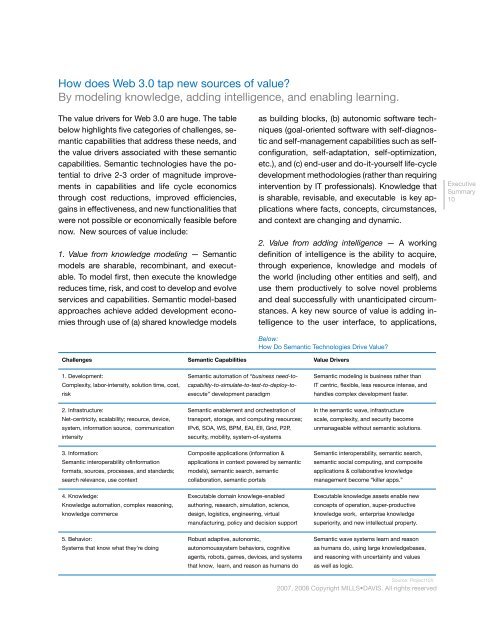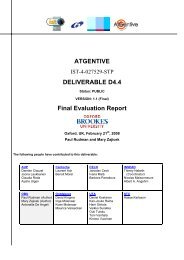Industry Roadmap to Web 3.0 & Multibillion Dollar ... - INSEAD CALT
Industry Roadmap to Web 3.0 & Multibillion Dollar ... - INSEAD CALT
Industry Roadmap to Web 3.0 & Multibillion Dollar ... - INSEAD CALT
You also want an ePaper? Increase the reach of your titles
YUMPU automatically turns print PDFs into web optimized ePapers that Google loves.
How does <strong>Web</strong> <strong>3.0</strong> tap new sources of value?<br />
By modeling knowledge, adding intelligence, and enabling learning.<br />
The value drivers for <strong>Web</strong> <strong>3.0</strong> are huge. The table<br />
below highlights five categories of challenges, semantic<br />
capabilities that address these needs, and<br />
the value drivers associated with these semantic<br />
capabilities. Semantic technologies have the potential<br />
<strong>to</strong> drive 2-3 order of magnitude improvements<br />
in capabilities and life cycle economics<br />
through cost reductions, improved efficiencies,<br />
gains in effectiveness, and new functionalities that<br />
were not possible or economically feasible before<br />
now. New sources of value include:<br />
1. Value from knowledge modeling — Semantic<br />
models are sharable, recombinant, and executable.<br />
To model first, then execute the knowledge<br />
reduces time, risk, and cost <strong>to</strong> develop and evolve<br />
services and capabilities. Semantic model-based<br />
approaches achieve added development economies<br />
through use of (a) shared knowledge models<br />
as building blocks, (b) au<strong>to</strong>nomic software techniques<br />
(goal-oriented software with self-diagnostic<br />
and self-management capabilities such as selfconfiguration,<br />
self-adaptation, self-optimization,<br />
etc.), and (c) end-user and do-it-yourself life-cycle<br />
development methodologies (rather than requiring<br />
intervention by IT professionals). Knowledge that<br />
is sharable, revisable, and executable is key applications<br />
where facts, concepts, circumstances,<br />
and context are changing and dynamic.<br />
2. Value from adding intelligence — A working<br />
definition of intelligence is the ability <strong>to</strong> acquire,<br />
through experience, knowledge and models of<br />
the world (including other entities and self), and<br />
use them productively <strong>to</strong> solve novel problems<br />
and deal successfully with unanticipated circumstances.<br />
A key new source of value is adding intelligence<br />
<strong>to</strong> the user interface, <strong>to</strong> applications,<br />
Below:<br />
How Do Semantic Technologies Drive Value?<br />
Executive<br />
Summary<br />
10<br />
Challenges Semantic Capabilities Value Drivers<br />
1. Development:<br />
Complexity, labor-intensity, solution time, cost,<br />
risk<br />
Semantic au<strong>to</strong>mation of “business need-<strong>to</strong>capability-<strong>to</strong>-simulate-<strong>to</strong>-test-<strong>to</strong>-deploy-<strong>to</strong>execute”<br />
development paradigm<br />
Semantic modeling is business rather than<br />
IT centric, flexible, less resource intense, and<br />
handles complex development faster.<br />
2. Infrastructure:<br />
Net-centricity, scalability; resource, device,<br />
system, information source, communication<br />
intensity<br />
Semantic enablement and orchestration of<br />
transport, s<strong>to</strong>rage, and computing resources;<br />
IPv6, SOA, WS, BPM, EAI, EII, Grid, P2P,<br />
security, mobility, system-of-systems<br />
In the semantic wave, infrastructure<br />
scale, complexity, and security become<br />
unmanageable without semantic solutions.<br />
3. Information:<br />
Semantic interoperability ofinformation<br />
formats, sources, processes, and standards;<br />
search relevance, use context<br />
Composite applications (information &<br />
applications in context powered by semantic<br />
models), semantic search, semantic<br />
collaboration, semantic portals<br />
Semantic interoperability, semantic search,<br />
semantic social computing, and composite<br />
applications & collaborative knowledge<br />
management become “killer apps.”<br />
4. Knowledge:<br />
Knowledge au<strong>to</strong>mation, complex reasoning,<br />
knowledge commerce<br />
Executable domain knowlege-enabled<br />
authoring, research, simulation, science,<br />
design, logistics, engineering, virtual<br />
manufacturing, policy and decision support<br />
Executable knowledge assets enable new<br />
concepts of operation, super-productive<br />
knowledge work, enterprise knowledge<br />
superiority, and new intellectual property.<br />
5. Behavior:<br />
Systems that know what they’re doing<br />
Robust adaptive, au<strong>to</strong>nomic,<br />
au<strong>to</strong>nomoussystem behaviors, cognitive<br />
agents, robots, games, devices, and systems<br />
that know, learn, and reason as humans do<br />
Semantic wave systems learn and reason<br />
as humans do, using large knowledgebases,<br />
and reasoning with uncertainty and values<br />
as well as logic.<br />
Source: Project10X<br />
2007, 2008 Copyright MILLS•DAVIS. All rights reserved
















